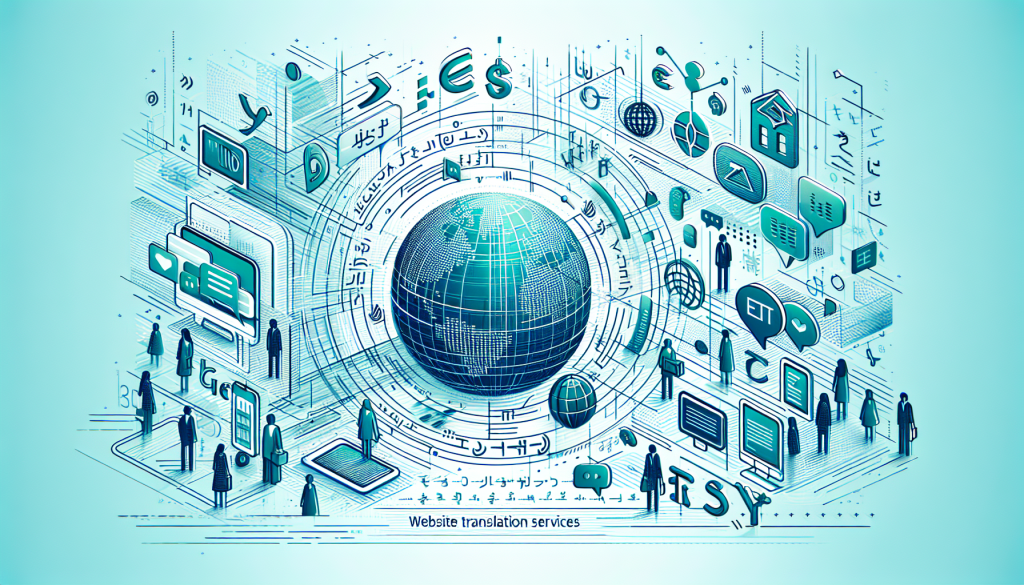Understanding Website Translation Services
In a globalized world, the need for website translation services has never been more crucial. Whether it's for individuals, businesses, educational institutions, or medical and travel agencies, these services play a key role in connecting global audiences and expanding international reach.
Why Website Translation Matters
When expanding globally, one of the biggest challenges companies face is communication. Effective communication is a cornerstone of successful business operations, and translation services can help overcome these challenges and ensure a smooth transition to global markets.
According to a study cited by Renaissance Translations, 60% of consumers said they are more likely to buy products or services from a website that is available in their own language. This indicates the importance of website translation services in engaging potential customers in new markets and ensuring that the message conveyed is clear and compelling.
Furthermore, these services can significantly increase website traffic and user engagement, as they make the website accessible to a wider audience. This accessibility is particularly important for sectors like travel and tourism, medical institutions, and educational institutions that aim to reach diverse audiences.
The Role of Localization in Translation
Website translation services are not just about translating content from one language to another. They also involve localization, a process that goes beyond translation to adapt the content to the cultural nuances and preferences of the target audience, ensuring a truly engaging and personalized experience.
Localization is essential for cultural adaptation in global expansion strategies, as it allows companies to adapt content to cultural differences, language peculiarities, local expectations, and legal requirements (Source).
In conclusion, understanding the importance of website translation services and the role of localization is the first step in achieving global reach. By leveraging these services, businesses can not only communicate effectively with international audiences but also build trust and credibility, leading to increased traffic, engagement, and ultimately, sales.
The Benefits of Website Translation
The decision to translate a website is a strategic move that can yield significant benefits. Understanding these benefits can help businesses, educational institutions, and other organizations make an informed decision about investing in website translation services.
Boosting International Sales
One of the primary benefits of a multilingual website is the potential to increase international sales. By translating your website into multiple languages, you can communicate with customers in their native language, potentially leading to more sales and revenue. Studies show that customers are more likely to make a purchase when a website is available in their native language. With website translation services, businesses can broaden their reach, tap into new markets, and increase their customer base, driving revenue growth.
Enhancing User Experience
A multilingual website can enhance the user experience by providing content that is culturally relevant and easily understandable for users from different linguistic backgrounds. This improved user experience can boost customer engagement and loyalty, leading to higher customer retention and conversion rates.
Improving SEO Rankings
Translating a website into multiple languages can also help improve search engine optimization (SEO) rankings. By including relevant keywords in each language, a multilingual website can improve its visibility and ranking on search engine results pages (SERPs) for users searching in those languages.
In the competitive online space, a higher visibility in international markets can provide an edge over businesses that only offer a single-language website. This increased visibility can attract more customers, further boosting international sales.
In summary, investing in website translation services can substantially increase a business's global reach, improve user experience, and boost SEO rankings. These benefits underline the importance of choosing a reputable and qualified certified translator to ensure the quality and accuracy of website translations.
Choosing the Right Translation Service
Selecting the right provider for website translation services is crucial to ensure a smooth and effective translation process. There are three main factors to consider during this selection process: the qualifications and experience of the service provider, the cost and timelines associated with the service, and the quality of translations provided.
Evaluating Qualifications and Experience
When it comes to choosing a translation service, the qualifications and experience of the translation team are of utmost importance. Experienced translators have a better understanding of the nuances of different languages, cultural contexts, and industry-specific terminologies.
A qualified translation team should ideally have proven expertise in providing translations for your specific industry, be it medical, technical, financial, or legal. You might also want to consider whether the translation service provider offers certified translators for documents that require certified translations, such as birth certificates or marriage certificates (Translation Partner).
Considering Costs and Timelines
The cost of website translation can vary significantly based on factors such as the size of the website, the number of languages to be translated, and the complexity of the content. According to Translation Partner, translation costs can range from $0.08 to $0.30 per word, depending on the language pair and the volume of content to be translated. Additional fees may also apply for services such as localization, keyword research, and quality assurance.
The timeline for website translation services can also vary depending on similar factors. Therefore, it is important to plan ahead and allow enough time for translation and review. Urgent translations might incur additional costs.
Assessing Translation Quality
Ensuring high-quality translations is crucial to maintain the integrity and credibility of your website content in various languages. Poor translations can harm your brand image and lead to misunderstandings or confusion among your audience.
Quality translations should be accurate, culturally appropriate, and tailored to your target audience. They should also maintain the tone and style of your original content. You can gauge the quality of a translation service by requesting samples of their previous work or seeking feedback from their past clients.
Choosing the right translation service is a critical step towards expanding your global reach. By carefully considering the qualifications and experience of the translation team, the costs and timelines associated with the service, and the quality of translations provided, you can find a service that best suits your needs and helps you connect effectively with your international audience.
The Role of SEO in Website Translation
When it comes to website translation services, it's not just about converting text from one language to another. Equally important is the role of Search Engine Optimization (SEO) in ensuring that the translated content reaches the right audience. In this section, we delve into the specifics of implementing multilingual SEO practices and using hreflang tags correctly.
Implementing Multilingual SEO Practices
Building a multilingual website is crucial for businesses that want to expand their reach and engage with customers from different cultures and languages. It requires careful consideration of the site's SEO strategy. Multilingual SEO involves optimizing the content on a website for different languages to reach different markets.
One recommended practice for multilingual websites is using dedicated URLs with a language indicator. This helps search engines and people identify the language on the website. Subdirectories, subdomains, or top-level domains can be used for the URL structure.
To ensure a smooth user experience, it is best to stick to one language per page. Having more than one translated language on a page can dilute the user experience and cause confusion.
Using Hreflang Tags Correctly
Hreflang tags are an important aspect of multilingual SEO. These tags should be applied to help Google determine the language of the page and the region it is intended for. Multiple hreflang tags can be added for pages intended for various regions.
By utilizing hreflang tags, search engines can effectively serve the correct language or regional URL in search results, making your content more accessible to your target audience.
In conclusion, the role of SEO in website translation is pivotal. Proper implementation of multilingual SEO practices and correct usage of hreflang tags can significantly improve the visibility and user experience of your translated website. Whether you're seeking to provide medical translation services or technical translation services, a well-optimized multilingual website can help you reach a global audience effectively.
Mistakes to Avoid in Website Translation
Website translation services play a vital role in global business, helping to bridge the linguistic gap and facilitate communication with international audiences. However, the process can be fraught with pitfalls if not handled correctly. Let's discuss a few critical mistakes that one should avoid in website translation.
Avoiding Multiple Languages on One Page
A common error in website translation is including multiple languages on a single page. While it may seem like a convenient way to cater to various linguistic audiences, this approach can confuse search engines and negatively impact your site's SEO performance. It can also lead to a poor user experience, as the page becomes cluttered and difficult to navigate.
Instead, it's recommended to create separate pages for each language or use a language switcher function. This approach ensures that each page is tailored to a specific linguistic audience, thereby improving user experience and SEO performance. Remember, the goal is to provide content that is culturally relevant and easily understandable for users from different linguistic backgrounds.
Ignoring Cultural Nuances
Another common pitfall in website translation is ignoring cultural nuances. Translation goes beyond merely converting words from one language to another; it involves adapting the content to the cultural context of the target audience. This process, known as localization, ensures a truly engaging and personalized user experience.
Ignoring cultural nuances can lead to miscommunication, misunderstandings, and even offend your international audience. For instance, certain colors, symbols, or phrases may have different connotations in various cultures. To avoid such issues, it's crucial to choose a website translation service that specializes in the target language and understands the cultural nuances of the target market.
In conclusion, avoiding these common mistakes in website translation can significantly enhance your website's user experience and SEO performance. It can also positively impact your company's reputation and credibility in the international market. Remember, by offering a multilingual website, you can gain a competitive advantage and attract more customers.
Case Study: Successful Website Translation
To grasp the impact of website translation services, let's delve into two case studies. These demonstrate the power of website translation in diverse sectors, namely, e-commerce and educational institutions.
Translation Success in E-commerce
Website translation services have proven to be a game-changer for e-commerce businesses. Studies have shown that customers are more likely to make a purchase when a website is available in their native language.
An e-commerce business that adopted website translation services experienced a significant increase in website traffic and user engagement. This was attributed to the fact that the website became accessible to a wider audience.
Moreover, translating their website into multiple languages allowed the business to communicate with customers in their native language, improving customer engagement and loyalty (PoliLingua). As a result, the business experienced an increase in sales and revenue, demonstrating the significant role that website translation services play in boosting international sales.
Translation Success in Education Institutions
Educational institutions also greatly benefit from website translation services. A university that translated its website into several languages experienced an increase in international applications. By offering a multilingual website, the university gained a competitive advantage and could attract more potential students (PoliLingua).
Translating the university's website improved the user experience by providing content that was culturally relevant and easily understandable for students from different linguistic backgrounds. This not only increased engagement but also built trust and credibility with international students.
In conclusion, these case studies highlight the importance of website translation services for businesses and institutions looking to expand their reach and tap into new markets. By providing content in multiple languages, it's possible to enhance user experience, boost engagement, and increase competitiveness. For more information on this topic, check our guide on certified translation services.






